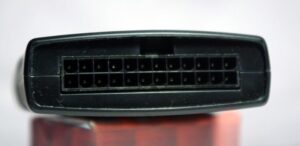Thermaltake Dr Power II Power Supply Tester Review
Jake Sedge / 12 years ago

[wpcol_1half id=”” class=”” style=””]
Thermaltake is a company that has been around for over a decade and has rose to fame by producing high-quality, innovative PC power and cooling products. Well known for their iconic Level 10 chassis and enthusiast power supplies, Thermaltake has been leading the way in terms of cooling product, chassis and PSU design.
PSUs are the unsung heros of just about every PC, after all, they don’t have the most glamorous job! They don’t improve your FPS, they won’t make your PC more responsive nor will they allow your components to run faster- they do the very simple job of giving power.
Although the job of a PSU seems simple enough, but the way it carries out it’s job even more important as the way a GPU produces a video output.
If a PSU isn’t up to the job, it can have literally explosive consequences. Not only is there the issue of poor quality units going bang, but when your computer stops working properly, no POST error code, it causes a huge headache when it comes to fault finding. PSUs are notoriously difficult to test, even if you get the PSU up and running you don’ t know if it distributing power properly or within a safe voltage range.
This is where Thermaltake’s Dr Power II steps in! This device is designed to be easy to use and instantly tell you whether or not a PSU is doing it’s job properly or if it is operating outside of an acceptable standard.
It is a pocket sized device that has 5 connectors and a power button making it usable by anyone and useful to anyone from a from a first time PC builder to a PC repair service doing diagnostic testing on computers.
The design of the Dr Power II gives it two primary functions, to test whether a power supply is working or not, and to check that it is operating within a safe voltage. Although this device is no replacement for full load testing equipment as it is unable to place a load on the unit, it would be able to instantly tell you whether or not a unit is ‘any good’.
For example, I have an old OEM PC with a 300W PSU, despite the fact that this device didn’t put a load on the unit it could tell me it was operating outside of ATX spec.
In addition, it told me that my cheap iCute PSU was just within the margins, so I could tell that the unit was unreliable and wouldn’t be up to the task at high loads.
However, to really test the quality of a unit you would require a vast and expensive array of testing equipment like we use for our power supply reviews, in comparison the Dr Power II is a useful ‘rule of thumb’ for testing quality and an essential device for checking functionality.
On the front of the device we can see the large screen and a simple design which contains some degree of styling. When in use, it is illuminated with a bright blue blacklight that clearly displays the black text that shows the voltages of the power rails.
Although the unit cannot show the voltage of the different 12V rails at once, pressing the power button allow you to measure the voltages from each connector, allowing you to check every 12V rail.
The button at the side is the only input method which makes the device outrageously easy to use!
[/wpcol_1half] [wpcol_1half_end id=”” class=”” style=””]
At the bottom is the connector for a 20 or 24-Pin ATX power connector, plugging this in will cause the blue screen to light up.
At the top there are 4 connectors, an EPS power connector for 4-pin or 8-pin, a PCIe connector for 8-pin or 6-pin, a MOLEX connector and a SATA connector. I’d have liked to have seen the PCIe and EPS connectors labelled because it is very difficult to tell the difference. They are however colour coded.
There are two ways of testing- by holding down the button for more than 5 seconds the device will automatically cycle through the different connectors and display the voltages. Should the result be below standard, it will turn red and beep.
To test manually, just tap the button and you can flick through the different connectors by tapping the button. Same principles apply if the voltage is outside of ATX spec.
The only feature I would have liked to have seen would be an option to use it as a device for starting PSUs which would be a useful tool for PC enthusiasts, especially watercoolers, who would be likely to buy this product. As much as a paperclip does the job, something a little more refined wouldn’t go amiss and would be a useful and easy feature to implement.
In conclusion, the Thermaltake Dr Power II is in incredibly useful tool that allows users ranging from first time builders fault finding their system to PC repair people to quickly and easily test power supplies to check whether they are functioning and how well they are doing their job.
In my opinion, every PC enthusiast should own one of these- if you like to constantly upgrade and tweak your system, it’s inevitable that something is eventually going to go wrong which can be extremely stressful, especially when you don’t get any POST diagnostic codes or when the system will power on for a second and instantly switch off, in these instances it is often left down to intuition or guesswork and can often lead to expensive, time consuming and unnecessary RMAs of products that actually work fine.
Power supplies are notoriously difficult to test- the only indications that they are actually working is a spinning fan and a powered up system, so when your system does not power up you may know that the PSU is on, but whether or not is distributing it’s power correctly is a different matter.
Dr Power II is an invaluable tool to have when you are trying to fault-find your PC, even if you buy it and it lays in your drawer for two years and you only end up using it once, it is still worth it’s money as a non-starting system can cost a fortune in cash and aggravation RMAing working components where a simple tool such as this would be able to tell you the answer instantly.


























